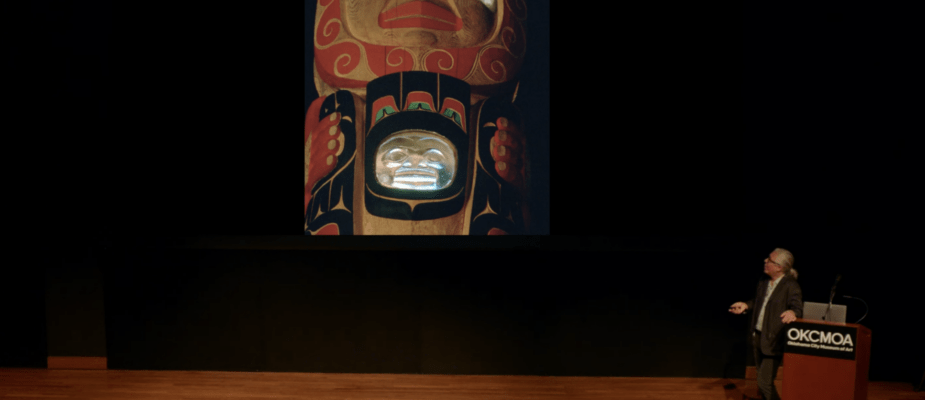By Amber Thompson, Marketing and Communications Coordinator
Preston Singletary, whose work is currently on view at OKCMOA in the exhibition Preston Singletary: Raven and the Box of Daylight, has a deep connection to Pilchuck Glass School in Stanwood, Washington. For over 50 years, this unique institution has been a place of innovation, community, and wonder. Founded in part by Dale Chihuly, the school has been important not only to Singletary, but also to many glass artists in OKCMOA’s permanent collection.
At OKCMOA’s Members’ Preview event for Preston Singletary: Raven and the Box of Daylight in November, Singletary discussed the communal nature of glass as a medium, stating that it is nearly impossible to create a work of glass alone. “Glassblowing is very collaborative,” he said. “It relies on a team to make much more complex and detailed things.” That same idea was foundational to the establishment of Pilchuck Glass School and one of the things that has sustained it for over 50 years.
Pilchuck is located about 40 miles north of Seattle, WA on land donated by John and Anne Gould Hauberg, who were patrons of the arts in the Pacific Northwest. The idea behind Pilchuck’s remote and idyllic environment was that it would allow for experimentation and could serve as a countercultural alternative to traditional art schools. The first summer of Pilchuck saw students and teachers learning from one another and working together as they built the school’s hot shop, shelters, and furnaces and gathered the equipment needed for a functioning glass school. The first year was one of near constant rain, little concept of time, and sleeping in tents. But it also saw a group of people deeply inspired by the lush green world around them—everything from hosting outdoor workshops and creating installations in the natural environment to racing the ever-present slugs was part of life at Pilchuck in 1971 and 1972.
Singletary arrived at Pilchuck at age 19, around the same time the school was becoming widely known. As a young man, Singletary dreamed of making a life and career for himself in music. To support this dream, he began working as a production glass blower at Pilchuck, and he participated in his first workshop at Pilchuck in 1984. Eventually Singletary began working on his own designs, first creating more traditionally shaped glass objects, and then, beginning in the late 1980s, works exploring Tlingit culture. The Tlingit are Indigenous peoples of the Pacific Northwest Coast, and Singletary was inspired in part by stories he heard from his Tlingit great-grandmother. To celebrate Pilchuck’s 30th anniversary in 2001, Singletary and other artists, including David Svenson, created a totem pole to honor the founders of Pilchuck. The work, which features glass, wood carving, and neon elements, speaks to the collaborative nature of Pilchuck.

Pilchuck’s collaborative environment has fostered in its artists a continued connection to the school. Like Singletary, who returned to teach on different occasions, many individuals represented in OKCMOA’s permanent collection exhibition Translucent Bodies: The Figure in Contemporary Studio Glass —on view on the Museum’s third floor—taught or studied at Pilchuck. Flora C. Mace was Pilchuck’s first woman instructor, and the institution is where she met longtime collaborator Joey Kirkpatrick. Karen LaMonte, Mark Abildgaard, Paul Marioni, Jay Musler, David Reekie, and Ginny Ruffner all at one time or another taught or lectured at Pilchuck, and Hank Murta Adams, Charles Parriott, and Steve Tobin studied at Pilchuck.
In the 1980s, more “back-to-basics” classes, like those led by Mace and Kirkpatrick, were added, and today, the offerings are considered “glass-plus” to encourage any number of creative directions glass artists choose to explore. Pilchuck has continued to grow in the twenty-first century, with 60 buildings spread over nearly as many acres. Because of what it refers to as an “intimate educational environment,” visitors are only welcomed onto the campus for very special occasions, but those who are curious can take a virtual tour of the grounds.
In considering the connections that OKCMOA has to Pilchuck and its artists, both in the Museum’s permanent collection and in Preston Singletary: Raven and the Box of Daylight, one might ponder which works of future Pilchuck greats will one day be found in our galleries.








